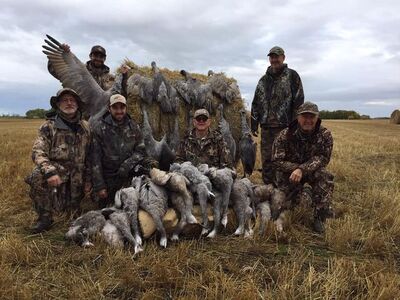To: Representative Paul Tittl Chair, Legislative Council Study Committee on Sandhill Cranes
The Case For Cranes: WI Says No To Crane Hunt

Great Lakes Wildlife Alliancr, on behalf of our supporters
Representative Paul Tittl
Chair, Legislative Council Study Committee on Sandhill Cranes
1ST FLOOR SW ROUND RM
WI STATE CAPITOL
2 E MAIN ST
MADISON, WI 53702
Dear Representative Tittl,
As advocates for wildlife conservation and habitat protection, we are writing to express our concerns regarding the application process and the selection of public members for the Legislative Council Study Committee on Sandhill Cranes. The sandhill crane population in Wisconsin is a vital part of our state's natural heritage, and any decisions related to their management should be made with utmost transparency and inclusivity.
While we appreciate the committee's intention to undertake a thorough, science-based examination of the bird's population, it is crucial that the process itself adheres to principles of openness and fairness. Here are our specific concerns:
The application review process should be transparent, and the criteria for selecting public members should be clearly communicated. As concerned citizens, we would like to know how applications were evaluated and what factors were considered during the selection.
In order to represent diverse perspectives, it is essential that public members include not only conservationists but also individuals from various backgrounds, including farmers, local communities, and other stakeholders. Transparency in the selection ensures that the committee truly reflects the interests of all Wisconsinites.
The decisions made by the committee should be based on the best available science. We urge the committee to engage with experts, researchers, and organizations with a deep understanding of sandhill crane ecology and behavior. Informed decisions will benefit both the cranes and our agricultural communities.
Public involvement is critical. We encourage the committee to hold open meetings, engage with concerned citizens, and actively seek input from those who have a vested interest in sandhill crane management. Transparency fosters trust and ensures that decisions are well informed
We must emphasize our strong opposition to the establishment of a hunting season for sandhill cranes. Hunting these majestic birds, which have only recently recovered from the brink of extinction, is not a solution to crop damage. It is a step backward in our conservation efforts. We believe that non-lethal methods and compensation programs for farmers can be effective alternatives that do not compromise the integrity of our wildlife populations.
In conclusion, we believe that Wisconsin's sandhill crane population deserves thoughtful and inclusive management. We appreciate your commitment to this important issue and hope that the committee's recommendations will reflect the best interests of both our wildlife and our citizens.
Thank you for your attention to these matters. We look forward to hearing about the committee's progress and findings.
Sincerely,
Representative Paul Tittl
Chair, Legislative Council Study Committee on Sandhill Cranes
1ST FLOOR SW ROUND RM
WI STATE CAPITOL
2 E MAIN ST
MADISON, WI 53702
Dear Representative Tittl,
As advocates for wildlife conservation and habitat protection, we are writing to express our concerns regarding the application process and the selection of public members for the Legislative Council Study Committee on Sandhill Cranes. The sandhill crane population in Wisconsin is a vital part of our state's natural heritage, and any decisions related to their management should be made with utmost transparency and inclusivity.
While we appreciate the committee's intention to undertake a thorough, science-based examination of the bird's population, it is crucial that the process itself adheres to principles of openness and fairness. Here are our specific concerns:
The application review process should be transparent, and the criteria for selecting public members should be clearly communicated. As concerned citizens, we would like to know how applications were evaluated and what factors were considered during the selection.
In order to represent diverse perspectives, it is essential that public members include not only conservationists but also individuals from various backgrounds, including farmers, local communities, and other stakeholders. Transparency in the selection ensures that the committee truly reflects the interests of all Wisconsinites.
The decisions made by the committee should be based on the best available science. We urge the committee to engage with experts, researchers, and organizations with a deep understanding of sandhill crane ecology and behavior. Informed decisions will benefit both the cranes and our agricultural communities.
Public involvement is critical. We encourage the committee to hold open meetings, engage with concerned citizens, and actively seek input from those who have a vested interest in sandhill crane management. Transparency fosters trust and ensures that decisions are well informed
We must emphasize our strong opposition to the establishment of a hunting season for sandhill cranes. Hunting these majestic birds, which have only recently recovered from the brink of extinction, is not a solution to crop damage. It is a step backward in our conservation efforts. We believe that non-lethal methods and compensation programs for farmers can be effective alternatives that do not compromise the integrity of our wildlife populations.
In conclusion, we believe that Wisconsin's sandhill crane population deserves thoughtful and inclusive management. We appreciate your commitment to this important issue and hope that the committee's recommendations will reflect the best interests of both our wildlife and our citizens.
Thank you for your attention to these matters. We look forward to hearing about the committee's progress and findings.
Sincerely,
Why is this important?
The application review process and the science being used, it might be helpful to request more information on how the decisions are made and what criteria are used to determine the “best available science.” Engaging in dialogue with the agencies or groups involved can lead to a better understanding and potentially influence the process to be more inclusive and transparent.
How it will be delivered
In person
